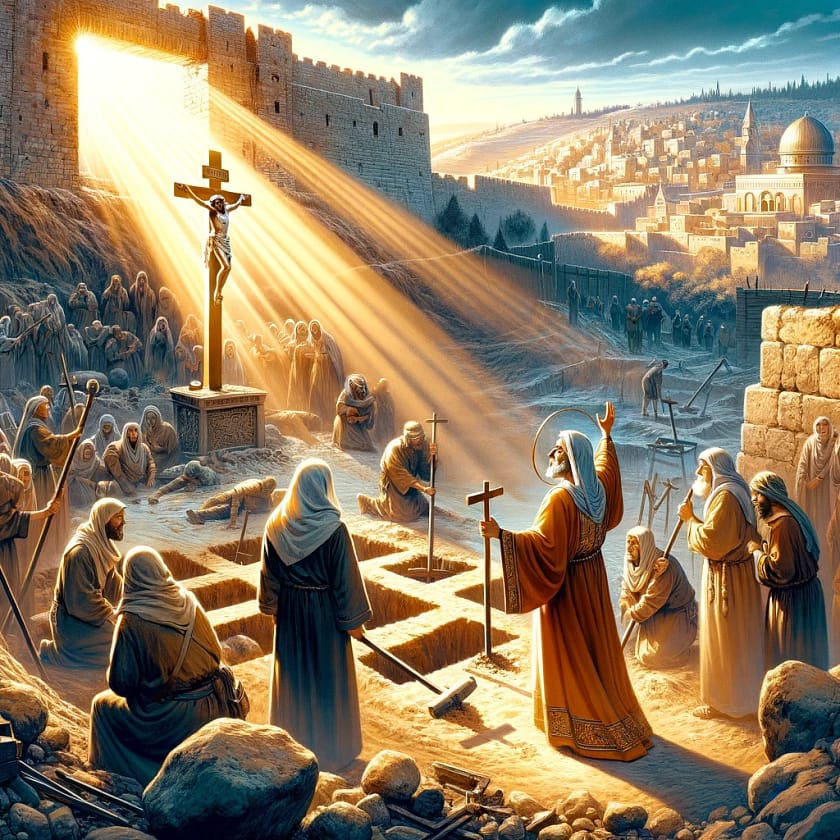The wood of the cross of Jesus
The wood of the cross on which Jesus was crucified, known in Christian tradition as the True Cross, is surrounded by various traditions and legends that have developed over centuries. These stories are part of the rich tapestry of Christian heritage, reflecting the veneration with which the True Cross is regarded. Here are some key traditions and legends related to the wood of the True Cross:
Discovery of the True Cross
Saint Helena’s Quest: The most famous tradition holds that the True Cross was discovered in the 4th century by Saint Helena, the mother of the Roman Emperor Constantine the Great, during her pilgrimage to the Holy Land. It is said that Helena found the cross on which Jesus was crucified buried under a temple dedicated to Venus, built by the Romans on Calvary, to suppress the Christian memory of the place. She also found the crosses of the two thieves who were crucified alongside Jesus. The True Cross was identified when a woman who was near death was touched by it and miraculously healed.
Miracles Attributed to the True Cross
Healing Powers: Numerous miracles have been attributed to the True Cross or fragments of it, including healings and the defeat of enemies. The True Cross was said to possess great power and was often used for protection and blessings.
Fragmentation and Distribution
Spread Across Christianity: Over the centuries, the True Cross was fragmented, and its pieces were spread across the Christian world in reliquaries. This distribution led to the proliferation of relics of the True Cross in churches and monasteries throughout Europe and the Middle East. The authenticity of these relics has often been a matter of faith rather than historical verification.
Theological Significance
Symbol of Sacrifice and Redemption: The wood of the True Cross is revered as a symbol of Jesus’ sacrifice and the redemption of humanity. It serves as a powerful devotional object, reminding the faithful of Jesus’ suffering and his victory over death.
Legends of the Wood’s Origin
The Legend of the Tree of Mercy: A legend dating back to the early Christian centuries tells of the Tree of Mercy, from which the wood of the Cross was taken. According to this legend, the tree grew from the seeds of the Tree of Knowledge of Good and Evil, which stood in the Garden of Eden, symbolizing a direct connection between the Fall of Man and the Redemption through Jesus Christ.
Cultural Impact
Art and Liturgy: The True Cross has been a significant theme in Christian art, literature, and liturgy. It has inspired countless works of art, hymns, prayers, and devotions, reflecting its central place in Christian faith and culture.
These traditions and legends, varying in detail and historical accuracy, highlight the deep spiritual and cultural significance of the True Cross in Christianity. They underscore the enduring impact of the crucifixion and the widespread veneration of relics associated with Jesus’ Passion.

Illustration depicting the discovery of the True Cross by Saint Helena in the 4th century. This scene captures the momentous occasion with Saint Helena at the excavation site, surrounded by workers, as they uncover the three crosses. A miraculous beam of light shines down, highlighting the True Cross, amidst the backdrop of ancient Jerusalem. This artwork reflects the awe and reverence associated with this significant event in Christian tradition.
Latest forensic results in the shroud
A tree shall bear salvation
Source OpenAI’s chatGPT Language Models, Dalle, AI trot and Fleeky
images Picsart and MIB
Invest in your future
Take time to learn
Embark on your journey in affiliate marketing and website creation alongside an incredible community and myself. Invest in your future by dedicating time to learn and earn. Take all the time you need to master the basics before aiming higher. Give it a try and sign up for free. You won't regret it! Discover the possibilities for yourself...


